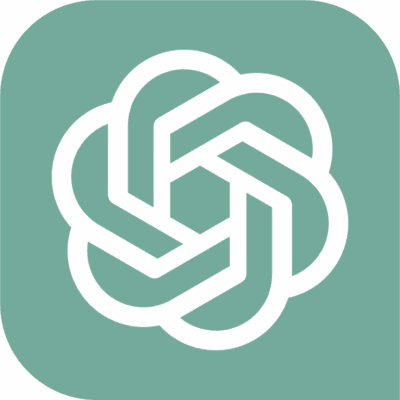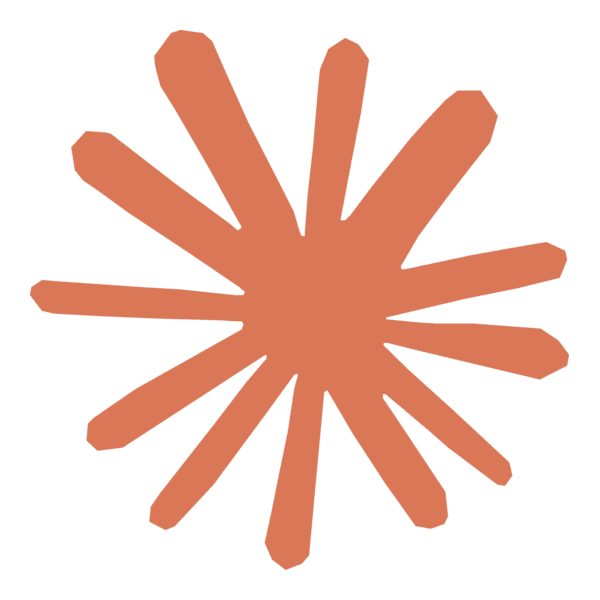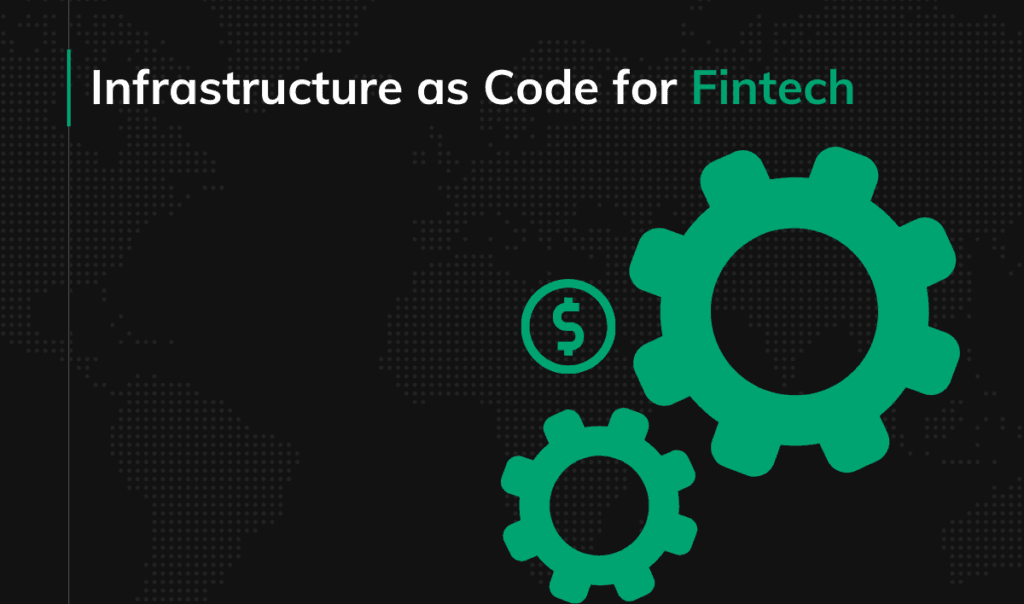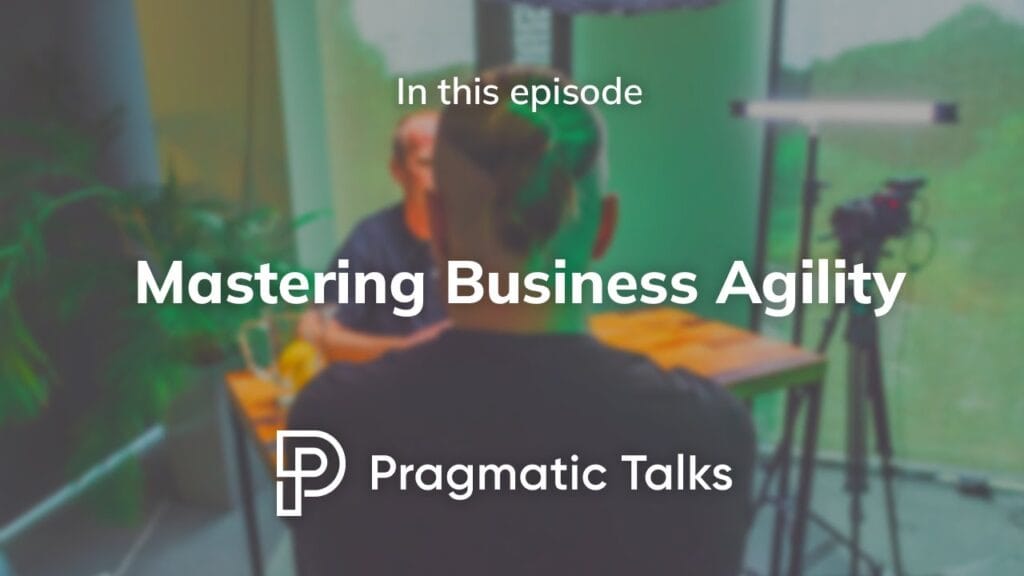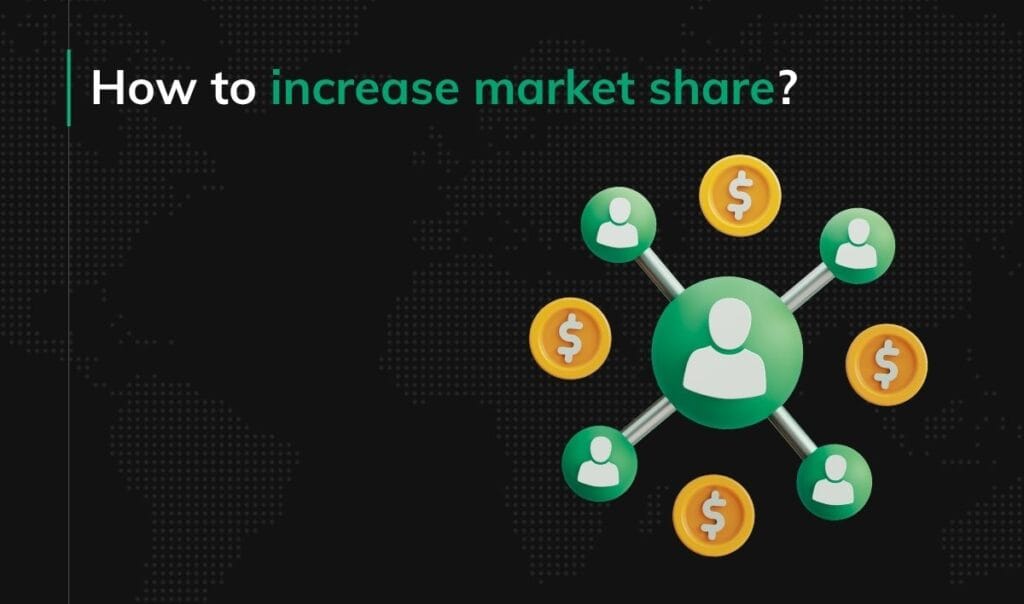How to gamify your business? Founder’s guide to gamification in business
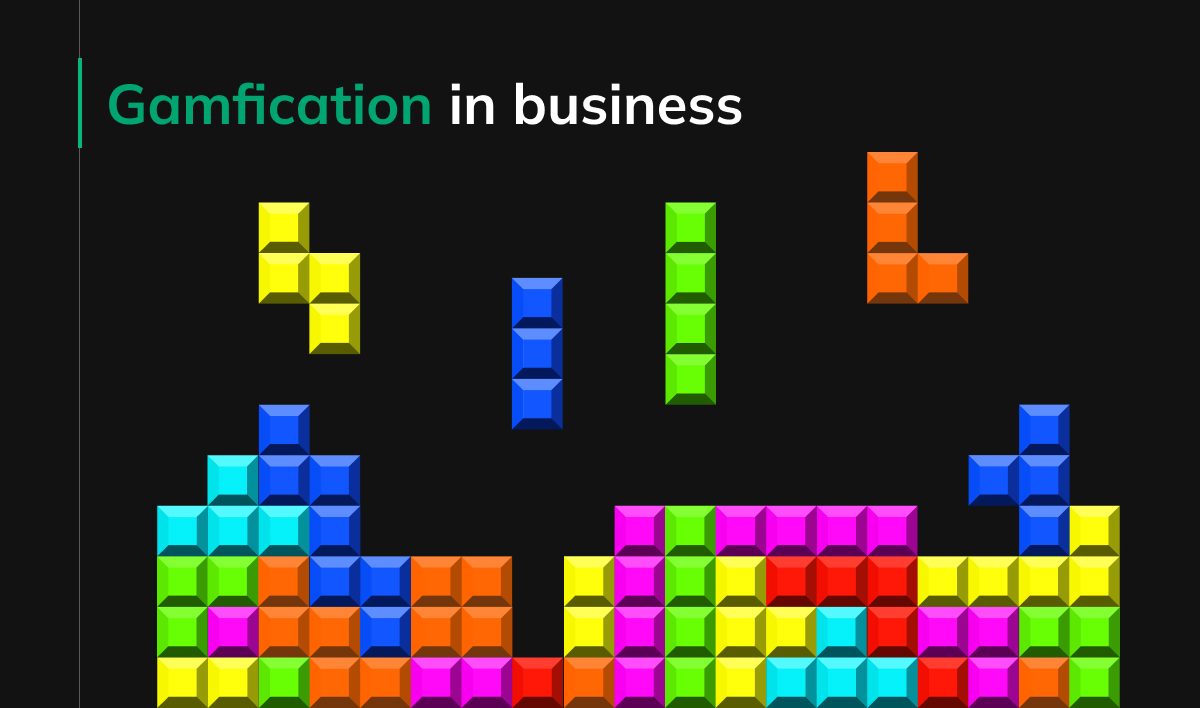
What does Instagram have in common with hitting the jackpot? Both are designed to keep you hooked.
Here’s the surprising truth: Instagram Reels were inspired by slot machines. They use surprise elements, quick bursts of fun videos, and the chance of going viral (like winning a jackpot) to make you keep swiping and watching. Just like the thrill of the casino, Reels keep you coming back for more.
This isn’t just a coincidence. It’s a strategy called gamification, and it’s not just a buzzword. From startups to giant companies, everyone’s using gamification to keep users engaged.
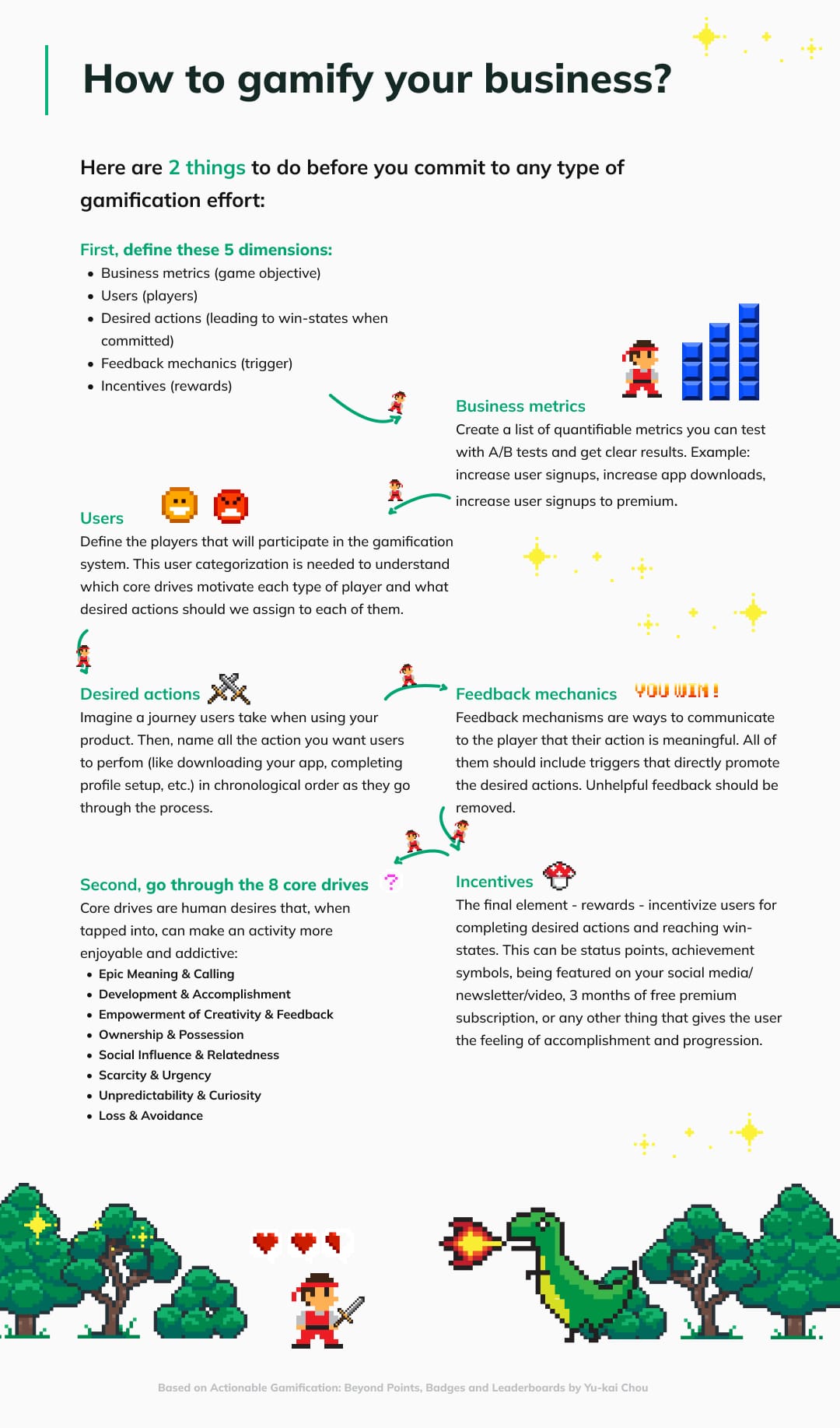
I. What is gamification and why does it work?
Gamification is using game elements and design in non-game settings (e.g., banking or healthcare apps) to boost customer engagement and motivation.
Why does it work? Gamification psychology
Yu-kai Chou is a pioneer in gamification and the author of Actionable Gamification: Beyond Points, Badges and Leaderboards. He created the Octalysis Framework, a popular tool for understanding human motivation through game design.
The framework consists of 8 core drives that motivate our behavior, and are the baseline for designing gamified systems:
1. Epic Meaning and Calling
This drive is about feeling that you are a part of something bigger than yourself. It taps into the intrinsic motivation of being chosen or called to a cause.
Wikipedia contributors often feel they are part of a mission to provide free knowledge to the world.
2. Development and Accomplishment
The motivation from achieving progress, developing skills, and overcoming challenges. Earning points, badges, and levels in a game provides a sense of accomplishment.
3. Empowerment of Creativity and Feedback
Encourages users to be creative and offers them continuous feedback. It involves engaging people in a creative process where they repeatedly figure things out and try different combinations, like when playing with LEGO bricks.
4. Ownership and Possession
When users feel ownership, they are motivated to make what they own better and be more engaged. I
n games like Animal Crossing, players invest time and effort into customizing their virtual spaces to make them more “theirs”.
5. Social Influence and Relatedness
We compare ourselves to others and to things inspired by what other people think, say, or do. These are all the social elements that inspired game themes like mentorship, competition, envy, group quests, social treasure, and companionship.
6. Scarcity and Impatience
This core drive is based on the desire to obtain something because it is rare, exclusive, or because you cannot have it immediately.
Think of limited-time offers and exclusive content in games creating a sense of urgency and value.
7. Unpredictability and Curiosity
The desire to find out what will happen next. When outcomes are uncertain, it creates excitement and engagement.
Example: Random loot boxes in games and cliffhangers in TV series.
8. Loss and Avoidance
Finally, this drive is based on the avoidance of negative outcomes. People are motivated to avoid losing something or to avoid pain. Mobile games often use the FOMO effect to make players return regularly for daily login rewards.
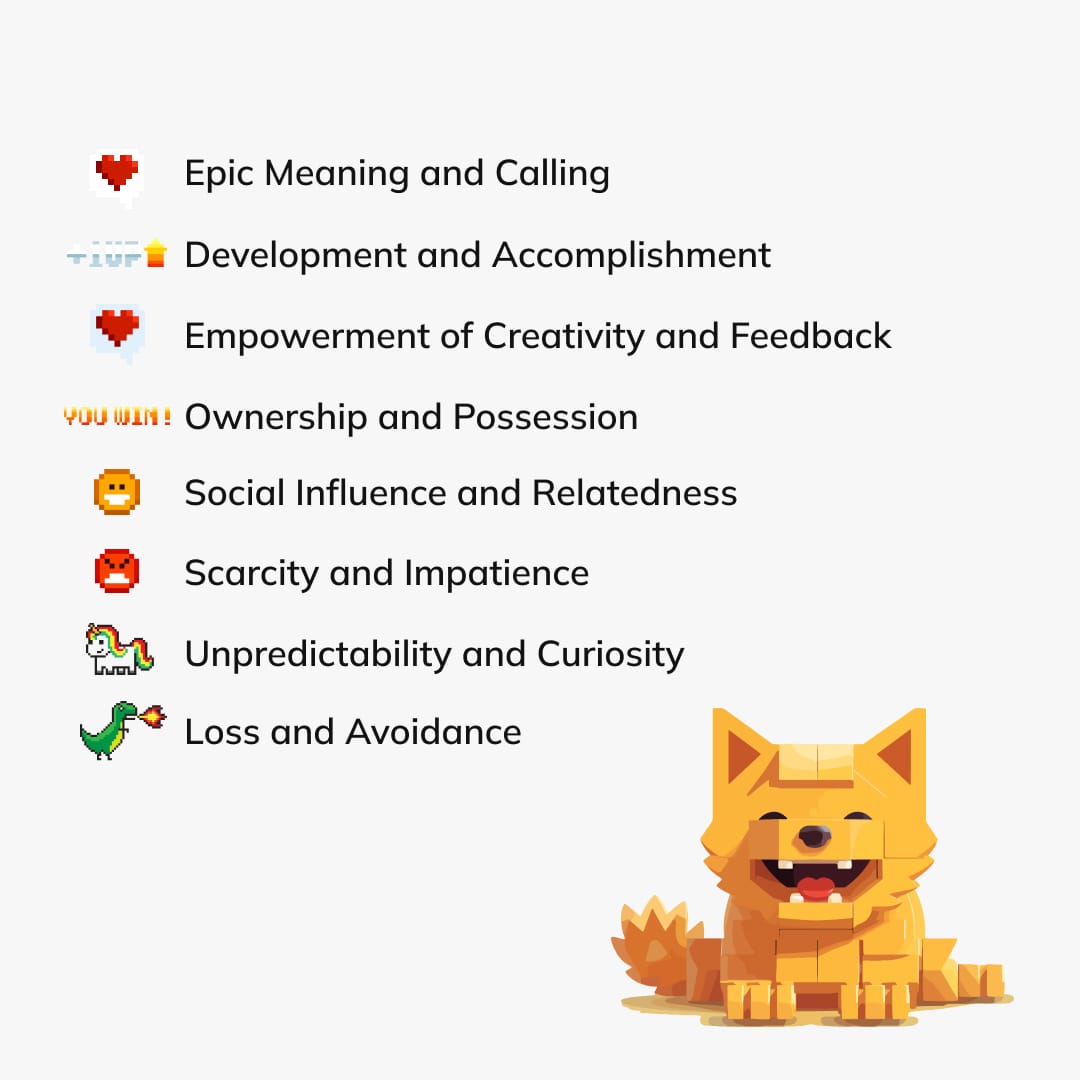 The Octalysis Framework: 8 core drives
The Octalysis Framework: 8 core drives
Within these 8 core drives, Yu-kai Chou distinguishes between white hat drives and black hat drives.
The first (Core Drives 1, 2, 3) are motivational elements that make users feel empowered, fulfilled, and in control. White hat drives should be used when aiming to create long-term engagement and positive user experiences, fostering feelings of empowerment and satisfaction. For this reason, white hat gamification can be great to implement in your workplace.
The second (Core Drives 6, 7, 8) leverage urgency, fear, and addiction to compel user action. Black hat gamification can be effective for short-term engagement or to prompt immediate action, but should be used sparingly to avoid user burnout and negative feelings. It might prove useful for more of “short-term” areas like sales (e-commerce) or fundraising.
II. What areas of your business can be gamified? Goals & benefits.
In your digital product business, there are three main areas that can be gamified.
- The product itself: You implement gamification techniques into your web or mobile app. The goal of in-app gamification is usually
- boosting user engagement which leads to…
- …improving user retention.
This, in turn, will translate to a higher chance of achieving your product’s core goals, e.g. driving sales.
- Marketing: Using game-like elements can serve as a way to promote your product and attract users to it.
- Workplace: Here, gamification can be used to motivate employees and increase engagement, or for swift employee training and onboarding. In a 2019 survey, 89% of employees felt game-like work would boost productivity, and 33% desired more game-like training software.
III. Gamification examples
Below, I compiled a list of examples of good and bad gamification in product marketing, app design, and workplace & employee management.
3 examples of gamification gone wrong
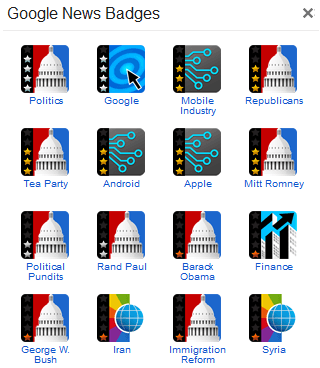
Google News Badges: Gamification nobody asked for
Sometimes, there are cases where organizations would have been better off without gamification altogether. Here are three examples of unsuccessful gamification efforts.
Disneyland’s “electronic whip”
Probably the most notorious example of bad gamification is the Disneyland case. In an attempt to supercharge laundry worker productivity, Disneyland implemented a system dubbed the ‘electronic whip.’ This dystopian-sounding monitor displayed individual worker output in real-time, turning laundry folding into a public competition. Names flashed green for those exceeding quotas, yellow for those struggling to keep pace, and a red for those falling significantly behind.
This experiment in gamification backfired spectacularly. The pressure to maintain a green status light fueled stress and anxiety among workers.
What began as friendly competition devolved into resentment. Bathroom breaks became luxuries, pregnant workers struggled to keep pace, and the incidence of injuries went up. (source)
Lyft & Google’s badges
Sometimes gamification just doesn’t make sense.
Lyft’s badge system rewarded users with badges for riding on specific days. While on paper it might have sounded like a good way to boost engagement, it backfires in practice. Imagine taking a Lyft ride on a random Tuesday, just to earn a “Travel Tuesday” badge – not exactly a compelling incentive. Unsurprisingly, this system failed to gain traction with users. (source)
Similarly, on July 14, 2011, Google introduced “Google News Badges”. The goal was to gamify the news reading experience by awarding users with badges based on the articles they read. However, this system did not resonate well with users and was retired in October 2012, along with a bunch of other unpopular, outdated or unneeded features.
Draw Something
“Draw Something” was a big hit in 2012.
In this mobile game, players drew pictures to represent words for their friends to guess. It initially thrived due to its smart use of gamification. Players enjoyed drawing pictures to represent challenge words, guessing friends’ drawings added a fun social element, and the unpredictability of guessing added suspense and engagement.
However, after Zynga acquired it, several issues led to the game’s decline. Players faced the same words repeatedly, which made the game boring.
The design encouraged starting new games constantly, which became overwhelming; playing started to feel like a chore, reducing enjoyment. Some players wrote the answer instead of drawing. This frustrated honest players, and made them quit.
3 examples of best gamification
 Airdropped prizes in Common Wealth’s Free Fund
Airdropped prizes in Common Wealth’s Free Fund
If executed properly, gamifying user experience can bring amazing business results, just as it did in the three examples below.
Common Wealth’s marketing strategy
The ability to invest in the most interesting blockchain projects at an early stage is reserved for a narrow group of people (influencers, VCs) – the mythical “1%.” Common Wealth is changing the game. They’re the world’s first VC fund that functions like “All Street” – making it the perfect investment option for the 99%.
Common Wealth is one of the products we’re actively helping to build right now. It heavily relies on gamification to boost user participation and engagement.
Let’s take their incentive programs, for example:
- Promotion (to promote the product and raise funds for its future development).
- Learn (users are rewarded for completing lessons on cryptocurrencies, blockchain, venture investing, or how to use the Common Wealth platform).
- Engage (users are rewarded for participating and contributing to the CW ecosystem on an ongoing basis).
One of the biggest events our team has been involved in lately was the Free Fund promotion.
For that, we built the gamification system (“Rewards” module) to promote the app. The system was based on completing missions (for example, liking a Common Wealth’s X post) for which users received XP. The winners received exclusive NFT airdrops. The system was accompanied by an admin panel that allowed us to verify whether a user has actually completed a mission.
Results?
– 1.64M missions completed – that’s 3,291 missions per hour!
– 63,000+ participants and registrations
– 1.7M new X followers
– There were 13M Free Fund impressions on X…
– … and overwhelmingly positive feedback from users. 🤟
Google’s workplace
Google made work fun and meaningful by giving employees a sense of purpose, opportunities to grow, and control over their projects. In chapter 14 of Actionable Gamification, Chou explains how they did it:
- Epic Meaning & Calling: Google’s mission statement (“organize the world’s information”) and motto (“Don’t be evil”) made employees feel like they were contributing to something important.
- Development & Accomplishment: They offered different levels for engineers, so they could advance in their careers without becoming managers, giving them a clear path to follow.
- Social Influence & Relatedness: The work environment was like a college campus, with a strong sense of community, which made it easier to collaborate and discouraged slacking off.
Dagens Næringsliv’s Fantasy Funds
A Norwegian business newspaper, Dagens Næringsliv (DN), struggled to attract young readers to their financial news content. Despite offering free access to students and discounts for young adults, they weren’t gaining traction.
Noticing young people’s growing interest in stocks during the pandemic, DN created Fantasy Funds, a stock market simulation game, in 2020. This free-to-play game uses virtual money and allows users to compete against friends. Importantly, no prior investment knowledge is required.
The game was a hit. It resulted in nearly 35,000 new young registered users for DN and 11.7 million page views on their website. Additionally, DN was able to convert 5% of these users into paying subscribers per season.
The success of Fantasy Funds goes beyond attracting new readers. It also allows DN to reach a younger audience for advertisers through in-game ads and prize sponsorships. (source)
IV. How to gamify?
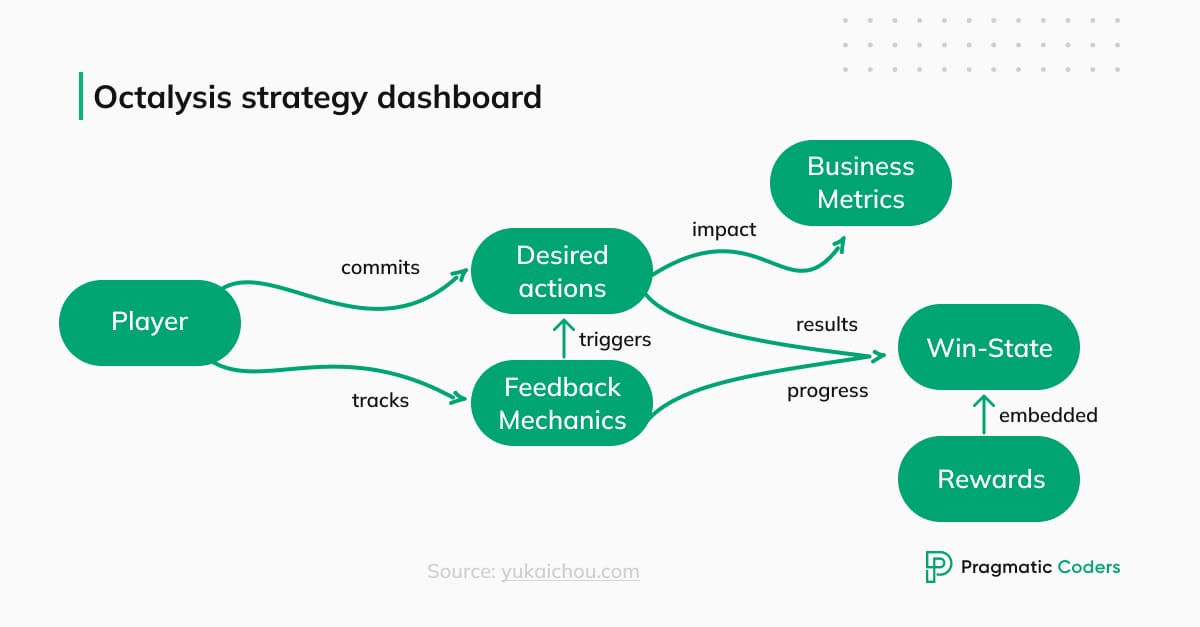
To propose a gamification step-by-step tutorial, I will again use Chou’s Octalysis strategy (for more, see Chapter 17 in his book).
To add gamification into your app: 1. define app goals, target users, desired actions, feedback triggers, and rewards; 2. think how to make the app itself fun and rewarding, without relying on external prizes or punishments.
Here’s a more detailed explanation of the process.
First, define these 5 dimensions:
- Business metrics (game objective)
- Users (players)
- Desired actions (leading to win-states when committed)
- Feedback mechanics (trigger)
- Incentives (rewards)
Second, go through the 8 core drives to generate fresh ideas that leverage these intrinsic motivators and encourage users towards the desired actions.
Business metrics
Create a list of quantifiable metrics you can test with A/B tests and get clear results. Example: increase user signups, increase app downloads, increase user signups to premium.
Users
Define the players that will participate in the gamification system. This user categorization is needed to understand which core drives motivate each type of player and what desired actions should we assign to each of them.
Desired actions
Name all the actions you want users to perform in chronological order in their player journey. The chronological order proposed by Chou is: Discovery, Onboarding, Scaffolding, Endgame. Here’s an example of such a list of desired actions for a basic fitness app.
- Discovery: sign-up, app download, explore the app’s features, watch an introductory video.
- Onboarding: complete profile setup, finish tutorial, finish first workout using the app.
- Scaffolding: follow a regular workout schedule (e.g. completing three workouts per week), reach specific fitness milestones, participate in community challenges.
- Endgame phase: achieve long-term fitness goals, contribute to the community (e.g. participating in forum discussions, sign up for premium subscription.
Feedback mechanics
Feedback mechanisms are ways to communicate to the player that their action is meaningful. All if them should include triggers that directly promote the desired actions. Unhelpful feedback should be removed.
- First, define the medium of communication with your users. These can be your app, website, social media, newsletter, etc.
- Second, figure out what feedback mechanics you can implement on each.
The feedback mechanisms are, in fact, what people call “gamification strategies”, “game mechanics”, “gamification features”, or “gamification examples” – points, badges, progress bars, leaderboard, etc. – and the list of the techniques contains waaay more items than the generic four I just mentioned.
Incentives
The final element – rewards – incentivize users for completing desired actions and reaching win-states. This can be status points, achievement symbols, being featured on your social media/newsletter/video, 3 months of free premium subscription, or any other thing that gives the user the feeling of accomplishment and progression.
8 core drives. Example
Suppose you want to build a gamification-based fitness app. The desired actions are to increase user signups, increase app downloads, and increase user signups to premium. A (simplified) Octalysis ideation process for it could look like this:
- Epic Meaning & Calling: “Join a movement for a healthier lifestyle!” – Highlight the app’s contribution to a larger well-being trend.
- Development & Accomplishment: Showcase user testimonials about achieving fitness goals through the app; provide badges and rewards for completing milestones like the first workout, first week of consistent exercise, etc.
- Empowerment of Creativity & Feedback: Offer customizable workout plans and allow users to create and share their own workout routines.
- Ownership & Possession: Let users track their fitness journey with detailed statistics and progress charts that they can personalize.
- Social Influence & Relatedness: Feature social media integration to share achievements and progress.
- Scarcity & Urgency: Offer limited-time premium trials and exclusive challenges that are only available for a short period.
- Unpredictability & Curiosity: Include mystery rewards, surprise challenges, and weekly updates with new content.
- Loss & Avoidance: Emphasize the negative consequences of an unhealthy lifestyle; send app reminders of the benefits users might miss out on if they don’t upgrade to premium, such as advanced analytics and personalized coaching.
V. Immersion. Future gamification trends
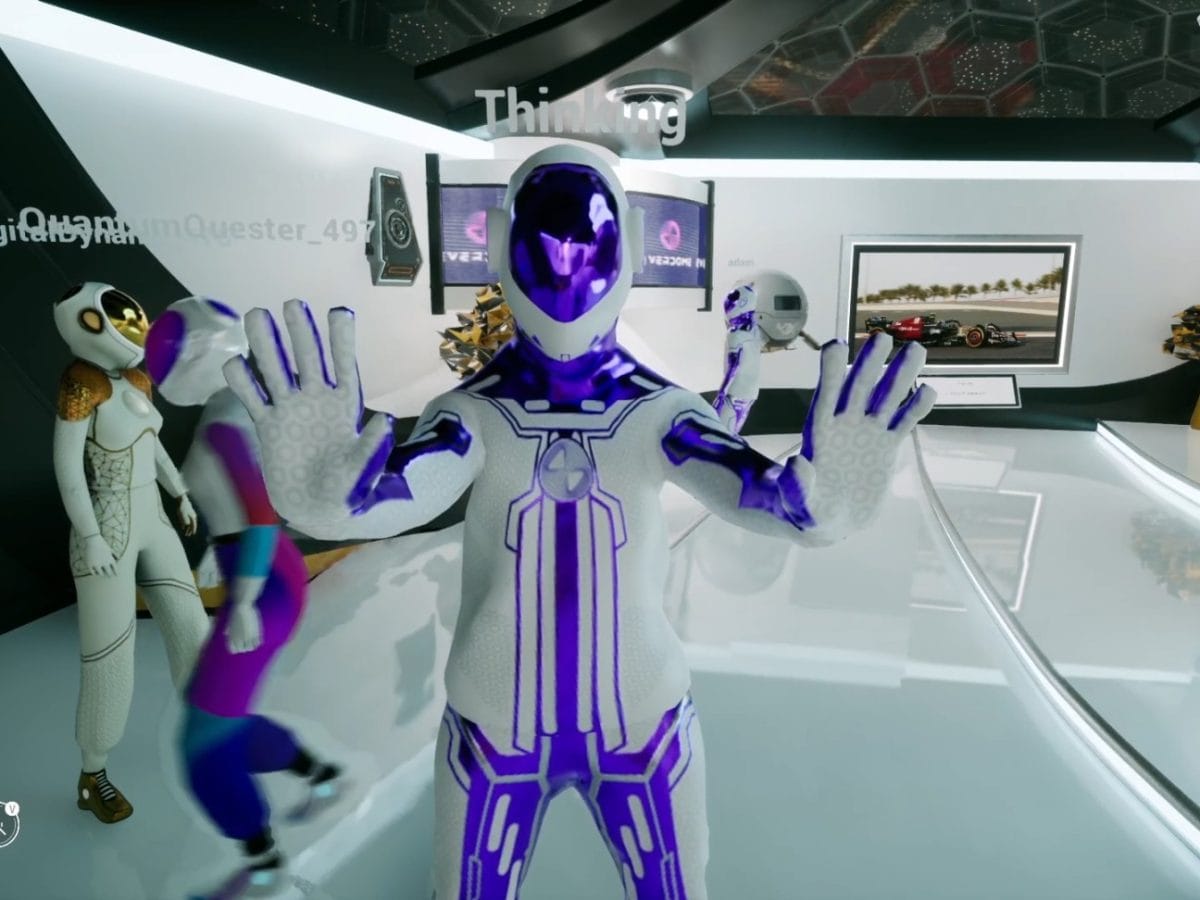 Everdome: A Metaverse Experience For All. Image: Edge Middle East
Everdome: A Metaverse Experience For All. Image: Edge Middle East
In the future, we’re going to see companies embrace cutting-edge technologies – AI, VR, AR – to attract new customers.
Walmart Realm
Just recently, Walmart launched a new virtual shopping experience called Walmart Realm. It features gamified shops designed around trending social media aesthetics like “So Jelly” (bright and colorful) and “Y’allternative” (western gothic glam). Users can explore these 3D environments, collect virtual rewards, and buy real Walmart products curated by influencers.
Walmart aims to attract younger generations (Gen Z and Gen Alpha) who spend a lot of time in online and gaming spaces. This is part of Walmart’s larger strategy to embrace new technologies (AR and immersive experiences) to meet customers where they are and shorten the gap between inspiration and shopping.
World of Rewards
Another example is ION Orchard, a shopping mall in Singapore. ION Orchard is revamping its customer loyalty strategy to target the growing demand for experiential retail. They recently launched an in-app augmented reality game called World of Rewards where shoppers can win prizes by visiting participating stores. This is in addition to their existing loyalty program that offers points for purchases. ION Orchard believes that gamification will not only increase customer engagement but also build brand loyalty.
Everdome: A Metaverse Experience For All
For over a year now, one of the product teams at Pragmatic Coders have been working on the Everdome project – a hyper-realistic metaverse experience aiming to be a social and commercial hub built on a future Martian civilization.
Everdome is designed to be a multifaceted metaverse experience. Users can explore this world, interact with other users, and attend events or gatherings. There’s even a marketplace where users can buy, sell, or trade virtual assets like land parcels.
What’s interesting, it holds great e-commerce potential: businesses and brands can host interactive experiences & engage with customers in a novel way.
Further reading
Here are a few reading recommendations you should consider checking out for an in-depth look into gamification.
- Actionable Gamification: Beyond Points, Badges and Leaderboards by Yu-kai Chou. It’s probably the most thorough exploration of how to use psychology and game design to create engaging experiences that drive results.
- Chou’s page, especially this high-level introductory article to gamification.
- Gamification-oriented blog with detailed analysis of gamification design, mechanics, and related topics.
- Reddit r/StartupManagement: Is gamification a good strategy or not?
- Feedback mechanics (aka gamification techniques) lists
- Understand gamification in banking: 2024 insights & opportunities
- Gamification in healthcare: Short guide for app founders
Conclusions. Gamification in business
This article is only the tip of the iceberg when it comes to gamification in business.
To make it make sense in your product, you need a well-thought out business strategy, excellent UX design, and, ideally, UX research tailored to your app and its users.
We’ve been building successful gamified products for years. Hop on a call with our team; we’ll discuss how to implement gamification into your product.


